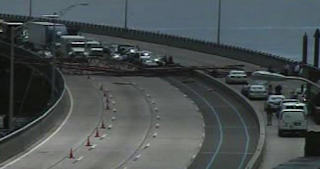Investigative reporter Jim Hoffer has teh details.
By Jim Hoffer
Updated 1 hr 44 mins ago
NEW YORK (WABC) -- The investigation into what caused the Tappan Zee Bridge crane collapse is underway, with weather already ruled out as a factor.
In the words of one crane expert, "something broke." The question is what and why.
How does a brand new crane, doing routine work suddenly collapse?
The 300-ton crawler crane with a vibrating hammer had been driving in huge bridge pilings when the the giant boom collapsed.
"If I were investigating the first thing is to see if the boom hoist cable broke," said crane investigator Thomas Barth.
Barth is one of the world's top crane accident investigators. He says the new crane's black box, like those in airplanes, will tell whether the crane had recently lifted too heavy a load.
"It tells you if any picks over the rated load charts," said Barth. "When you stress the machine out it may not break at that time, it could be months or years later because of the stress."
It was just five months ago in Lower Manhattan that the collapse of a crawler crane's boom in high winds killed one and injured three people.
The head of the $4 billion Tappan Zee Bridge project says in this case wind was not a factor.
"It was either a problem with the crane, problem with the hammer or it's operator," said Terry Towle, president of Tappan Zee Constructors.
As the largest building site in America, the building of the Tappan Zee has gone fairly smoothly, although five people have died in two separate accidents involving boats hitting a barge.
Had this boom collapse happened at rush hour, there could have been numerous fatalities. In the end, the blame for this close call as with most crane accidents will likely point in one direction.
"It's not the crane's fault, it is human error," said Barth.
Accident investigators say the crane's maintenance records are key to the investigation as is the experience of the crane operator.
What is interesting is that this new crane has a computer in it that would alert the operator if the load he's lifting is stressing the crane, making overload accidents less likely.







